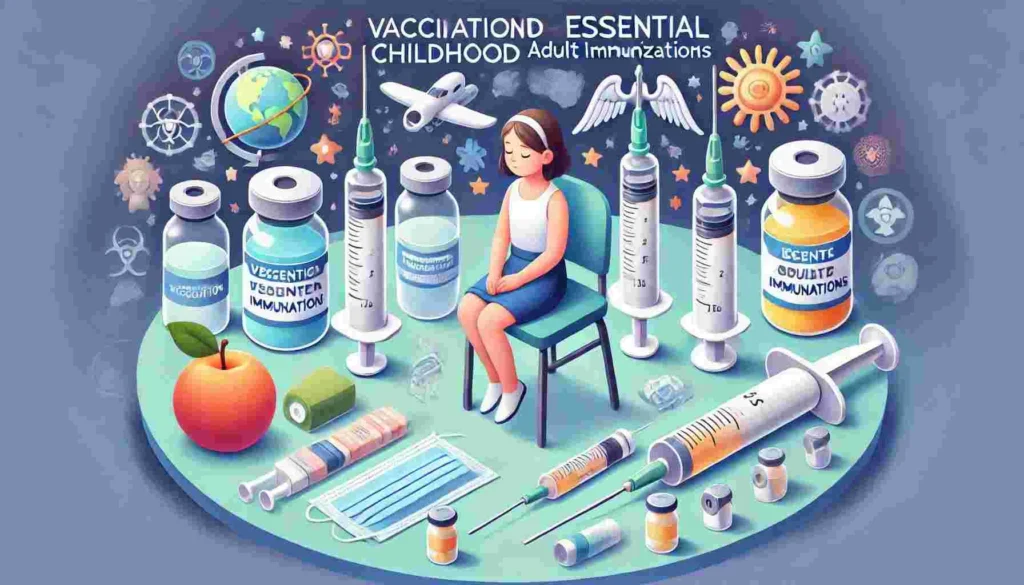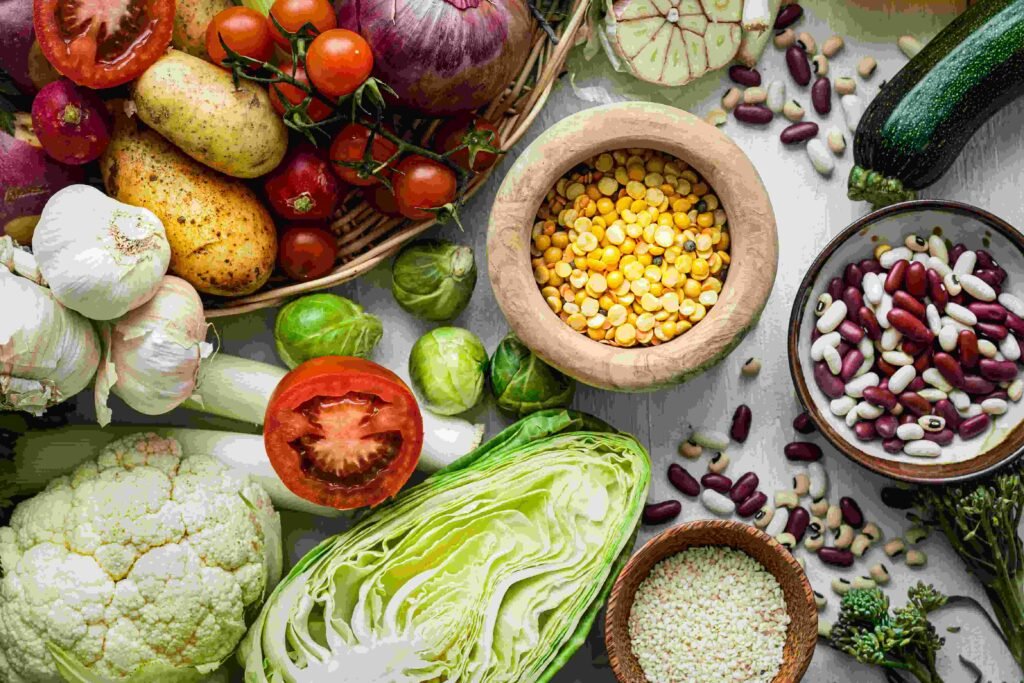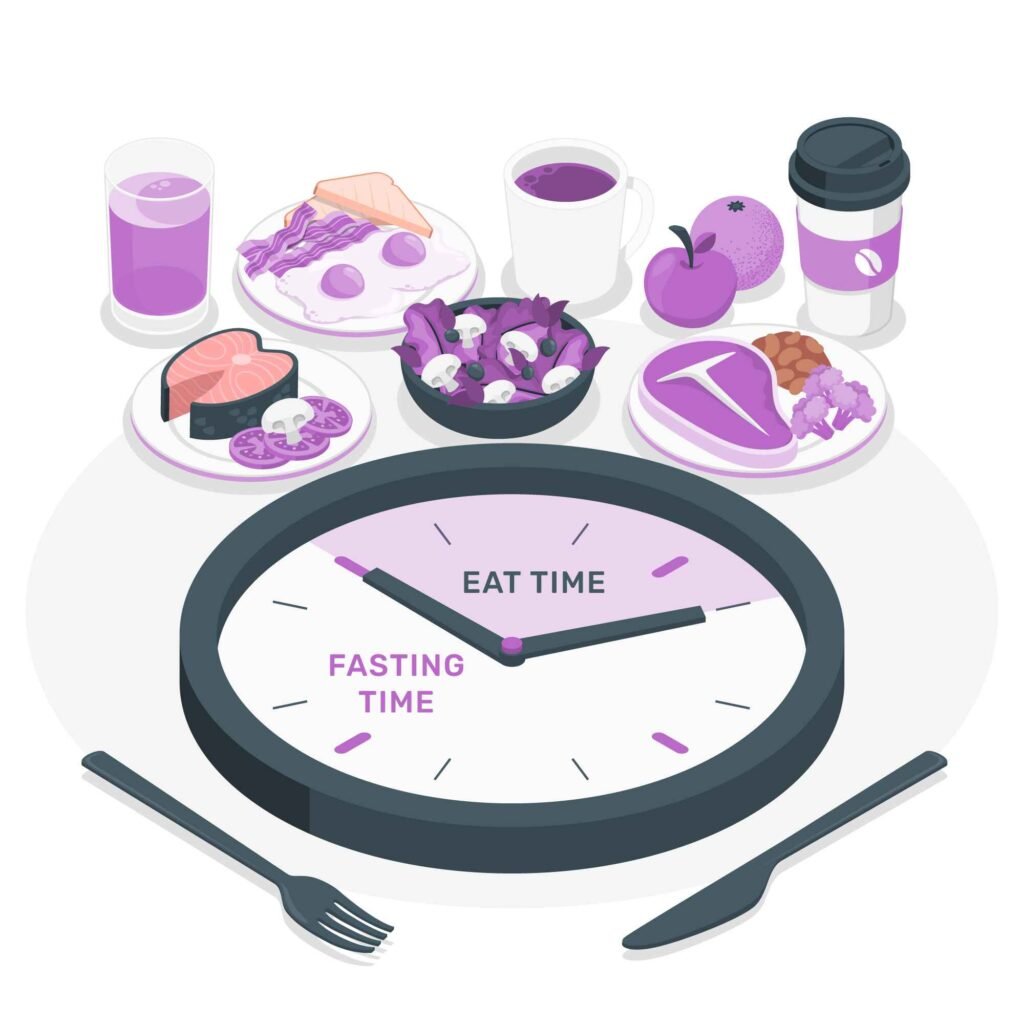
Vaccination Beyond Childhood: Essential Adult Immunizations
Introduction
Vaccination is often associated with childhood, but the need for immunization doesn’t end after early years. Adults face a variety of health risks, including the resurgence of certain diseases, exposure during travel, and vulnerabilities due to aging or chronic conditions. Staying up-to-date on vaccinations is a critical component of preventive healthcare.
This blog will explore the essential adult immunizations, addressing why they matter and how they contribute to long-term health and well-being.
Why Adult Immunizations Are Important
Protecting Against Preventable Diseases
While childhood vaccines lay the groundwork for protection, immunity can wane over time. Additionally, new vaccines emerge, and adults may encounter risks not present in childhood. Immunizations are crucial for shielding against diseases like influenza, shingles, and pneumonia that disproportionately affect adults.
Safeguarding Vulnerable Populations
Adults play a pivotal role in preventing the spread of infectious diseases to at-risk groups, such as infants, the elderly, or those with weakened immune systems. For instance, the Tdap vaccine not only protects against tetanus, diphtheria, and pertussis but also helps prevent the spread of whooping cough to newborns.
Travel and Global Exposure
International travel exposes adults to pathogens not commonly found in their home country. Vaccines like those for hepatitis A, typhoid, or yellow fever are recommended for travelers visiting certain regions, helping to prevent serious illness abroad.
Common Vaccines Recommended for Adults
1. Influenza Vaccine (Flu Shot)
- Who Needs It? All adults, especially those over 65, pregnant women, and individuals with chronic conditions.
- Why It’s Important: Seasonal flu can lead to severe complications, hospitalizations, or even death, particularly for high-risk populations. An annual flu shot offers the best protection.
2. Tetanus, Diphtheria, and Pertussis (Tdap)
- Who Needs It? Adults every 10 years, or during pregnancy (for pertussis protection).
- Why It’s Important: Tetanus infections can be life-threatening, and pertussis (whooping cough) outbreaks continue to occur. Boosters ensure ongoing immunity.
3. Shingles Vaccine (Shingrix)
- Who Needs It? Adults aged 50 and older.
- Why It’s Important: Shingles, caused by the reactivation of the chickenpox virus, leads to painful rashes and long-term nerve pain. Vaccination can significantly reduce the risk.
4. Pneumococcal Vaccines (PCV13 and PPSV23)
- Who Needs It? Adults over 65 or younger individuals with chronic conditions such as diabetes or heart disease.
- Why It’s Important: These vaccines protect against pneumonia, bloodstream infections, and meningitis, which are leading causes of death in older adults.
5. Human Papillomavirus (HPV) Vaccine
- Who Needs It? Adults up to age 26 who weren’t vaccinated in adolescence; certain high-risk adults up to age 45.
- Why It’s Important: HPV causes several types of cancers, including cervical, throat, and anal cancers. Vaccination reduces the risk of these cancers significantly.
Misconceptions About Adult Vaccines
“I Was Vaccinated as a Child, So I’m Covered”
Immunity from some vaccines diminishes over time. Diseases like tetanus and pertussis require boosters to maintain protection.
“Vaccines Are Only for the Elderly or Sick”
While older adults and those with chronic illnesses benefit the most, vaccines are essential for healthy adults, too. Preventing illness ensures continuity of work, travel, and overall well-being.
“Natural Immunity Is Better Than Vaccination”
Recovering from diseases like the flu or shingles can have severe consequences, such as hospitalization or long-term health effects. Vaccines provide immunity without the risks associated with the disease itself.
Addressing Vaccine Hesitancy
Despite the clear benefits, some adults remain hesitant to receive vaccines due to myths, misinformation, or fear of side effects.
- Education Matters: Trusted healthcare providers play a vital role in dispelling myths and providing accurate information.
- Vaccine Safety: Most adult vaccines have been rigorously tested and are safe with minimal side effects, such as mild soreness at the injection site.
- Convenience Counts: Pharmacies and community health clinics often provide vaccines, making it easier than ever for adults to stay updated.
How to Get Started with the Pegan Diet
1. Begin with a Pantry Makeover
Starting the Pegan Diet requires a shift in your food choices. The first step is to clean out your pantry and stock it with Pegan-friendly staples. Here’s a guide to get you started:
- Vegetables: Fresh, frozen, or fermented options like kale, spinach, broccoli, bell peppers, and carrots.
- Fruits: Low-glycemic options like berries, apples, pears, and citrus fruits.
- Healthy Fats: Avocados, extra virgin olive oil, coconut oil, nuts, and seeds.
- Proteins: Grass-fed meats, pasture-raised poultry, wild-caught fish, and free-range eggs.
- Grains: Gluten-free options like quinoa, buckwheat, and wild rice (in moderation).
- Plant-Based Alternatives: Almond milk, coconut milk, and dairy-free cheese alternatives.
Decluttering your pantry helps eliminate temptation and makes it easier to stick to Pegan principles.
2. Plan Your Meals Ahead
Creating a weekly meal plan can simplify your transition to the Pegan Diet. Aim for a balanced plate that includes:
- 75% vegetables and fruits
- 25% high-quality protein and healthy fats
Sample Meal Plan Ideas:
- Breakfast: Sautéed spinach, mushrooms, and avocado with poached eggs.
- Lunch: Grilled chicken salad with mixed greens, cherry tomatoes, walnuts, and a lemon-olive oil dressing.
- Dinner: Baked salmon with roasted cauliflower, asparagus, and a side of quinoa.
Having a plan helps you avoid last-minute unhealthy choices and keeps you on track.
3. Batch Cooking for Convenience
Batch cooking is a game-changer when following the Pegan Diet. Set aside time once or twice a week to prepare and store meals. Here are some tips:
- Roast a large tray of vegetables (carrots, broccoli, and bell peppers) for easy side dishes.
- Prepare a protein source like grilled chicken, turkey meatballs, or baked fish in bulk.
- Make homemade sauces and dressings with healthy fats, such as tahini, lemon-olive oil, or avocado-based dressings.
This way, you’ll have nutrient-dense, Pegan-friendly meals ready to go when you’re short on time.
Top Pegan Diet Recipes to Try
1. Cauliflower Rice Stir-Fry with Shrimp
Ingredients:
- 2 cups cauliflower rice
- 1 cup mixed bell peppers, chopped
- 1 cup broccoli florets
- 1/2 pound wild-caught shrimp
- 2 tbsp coconut aminos
- 1 tbsp coconut oil
- Fresh herbs (cilantro or parsley)
Instructions:
- Sauté shrimp in coconut oil until pink.
- Add bell peppers and broccoli, cooking until tender.
- Stir in cauliflower rice and coconut aminos.
- Garnish with fresh herbs and serve.
2. Zucchini Noodles with Pesto and Chicken
Ingredients:
- 2 medium zucchinis, spiralized
- 1 cup cherry tomatoes, halved
- 1 grilled chicken breast, sliced
- 2 tbsp homemade pesto (basil, olive oil, pine nuts, garlic)
Instructions:
- Sauté zucchini noodles until just tender.
- Toss with cherry tomatoes and pesto.
- Top with grilled chicken slices and serve warm.
3. Avocado and Berry Smoothie Bowl
Ingredients:
- 1 ripe avocado
- 1 cup frozen berries (blueberries, strawberries)
- 1 cup unsweetened almond milk
- 1 tbsp chia seeds
- 1 tbsp almond butter
Instructions:
- Blend avocado, berries, and almond milk until smooth.
- Pour into a bowl and top with chia seeds and almond butter.
These recipes are simple, nutritious, and align perfectly with Pegan Diet principles.
Tips for Staying Committed to the Pegan Diet
1. Focus on Progress, Not Perfection
Adopting the Pegan Diet is a journey. Don’t stress over being perfect; instead, focus on making small, consistent changes. If you occasionally eat a grain or dairy product, it’s okay. The key is to stick to the core principles as much as possible.
2. Listen to Your Body
Pay attention to how your body responds to different foods. Everyone’s nutritional needs are unique. If certain foods cause discomfort, consider eliminating or adjusting your intake. The Pegan Diet is about personalized nutrition and finding what works best for you.
3. Stay Hydrated
Drinking enough water is essential for optimal health. Aim for at least 8-10 glasses of water per day. You can also incorporate herbal teas, like green tea or chamomile, for additional health benefits.
4. Educate Yourself
The more you know about the Pegan Diet, the easier it is to stick with it. Follow health experts, read books, and join online communities for support. Knowledge empowers you to make healthier choices.
Common Myths About the Pegan Diet
1. Myth: The Pegan Diet is Too Complicated
Reality: While the Pegan Diet combines two dietary philosophies, the principles are straightforward. Focus on eating whole foods, lots of vegetables, healthy fats, and quality proteins. Once you understand the basics, it’s simple to follow.
2. Myth: You Won’t Get Enough Protein
Reality: The Pegan Diet includes both plant-based and animal-based proteins. As long as you incorporate sources like wild-caught fish, pasture-raised poultry, eggs, and plant-based options (nuts, seeds, legumes in moderation), you’ll meet your protein needs.
3. Myth: It’s Too Expensive
Reality: While some high-quality foods can be pricey, the focus on vegetables, fruits, and batch cooking can help balance costs. Buying in bulk, shopping seasonally, and visiting farmers’ markets can also save money.
The Pegan Diet: A Sustainable Path to Health
The Pegan Diet isn’t just a trend; it’s a lifestyle choice that promotes long-term health, environmental responsibility, and ethical eating. By combining the best aspects of the Paleo and Vegan diets, you benefit from a balanced approach to nutrition that supports:
- Better blood sugar control
- Reduced inflammation
- Sustainable weight management
- Improved heart health
Key Vaccines for Specific Life Stages and Situations
1. Hepatitis A and Hepatitis B Vaccines
- Who Needs Them?
- Hepatitis A: Adults traveling to regions with poor sanitation, men who have sex with men, and those with chronic liver disease.
- Hepatitis B: Healthcare workers, people with diabetes, adults with multiple sexual partners, and those who weren’t vaccinated as children.
- Why They Matter:
Hepatitis A spreads through contaminated food or water, causing liver inflammation. On the other hand, hepatitis B is a more severe infection that can become chronic and lead to liver cancer or cirrhosis. Therefore, vaccination helps protect against these serious illnesses.
2. MMR (Measles, Mumps, Rubella) Vaccine
- Who Needs It? Adults born after 1957 who haven’t received two doses of MMR or lack immunity.
- Why It’s Important: Although measles and mumps were once considered childhood diseases, outbreaks still occur. These diseases can lead to severe complications like encephalitis or hearing loss. Moreover, rubella poses a serious risk to pregnant women and their unborn children. Therefore, staying protected is crucial.
3. Meningococcal Vaccine
- Who Needs It? Adults in high-risk groups, such as college students living in dorms, military recruits, or those traveling to regions where meningitis is prevalent.
- Why It’s Important: Meningococcal disease can lead to life-threatening meningitis or bloodstream infections. Consequently, vaccination helps prevent rapid disease spread in close-contact environments.
4. Varicella (Chickenpox) Vaccine
- Who Needs It? Adults who haven’t had chickenpox or weren’t vaccinated in childhood.
- Why It’s Important: Chickenpox can cause severe illness in adults, including pneumonia or encephalitis. Additionally, adults who contract chickenpox are at higher risk of developing shingles later in life. As a result, getting vaccinated is a wise decision.
Travel Vaccines: What to Know Before You Go
When planning international travel, certain vaccines become essential for staying healthy and avoiding infectious diseases prevalent in other parts of the world.
1. Typhoid Vaccine
- Who Needs It? Travelers visiting regions with poor sanitation, such as parts of Africa, Asia, and South America.
- Why It’s Important: Typhoid fever spreads through contaminated food and water, leading to prolonged fever, diarrhea, and severe complications if untreated. Therefore, vaccination is a critical step for travelers.
2. Yellow Fever Vaccine
- Who Needs It? Travelers visiting countries in South America or sub-Saharan Africa where yellow fever is endemic.
- Why It’s Important: Yellow fever can cause severe liver damage, bleeding, and even death. Furthermore, many countries require proof of vaccination for entry. Consequently, planning ahead is essential.
3. Japanese Encephalitis Vaccine
- Who Needs It? Travelers spending extended time in rural areas of Asia, particularly during mosquito season.
- Why It’s Important: This virus can cause brain inflammation, leading to permanent neurological damage or death. Hence, vaccination is a crucial preventive measure.
4. Cholera Vaccine
- Who Needs It? Travelers going to regions with ongoing cholera outbreaks or poor water quality.
- Why It’s Important: Cholera causes severe diarrhea and dehydration, which can be life-threatening without treatment. Therefore, getting vaccinated can help you avoid this serious illness.
Vaccination for Pregnant Women: Essential Protection
Pregnancy is a critical period for both maternal and fetal health, and vaccines play a significant role in protecting both.
1. Tdap Vaccine (Tetanus, Diphtheria, and Pertussis)
- When to Get It: Between 27 and 36 weeks of pregnancy.
- Why It’s Important: This vaccine provides protection against whooping cough, which can be fatal for newborns. Additionally, mothers pass antibodies to their babies, providing early immunity. Therefore, this vaccine is essential during pregnancy.
2. Influenza Vaccine
- When to Get It: During any trimester of pregnancy.
- Why It’s Important: Pregnant women are at higher risk for severe flu complications. Moreover, the flu shot protects both the mother and the newborn during the first few months of life. As a result, getting vaccinated can prevent serious health issues.
3. COVID-19 Vaccine
- When to Get It: At any stage of pregnancy.
- Why It’s Important: COVID-19 infection during pregnancy can lead to severe illness and preterm birth. Furthermore, vaccination reduces these risks and helps protect the baby. Therefore, staying up-to-date with COVID-19 vaccines is highly recommended.
Staying on Top of Your Vaccination Schedule
Keeping track of your vaccines ensures you stay protected throughout your life. Here are some practical tips to help you stay on schedule:
Check Your Vaccination Records
It’s easy to lose track of your immunization history. Therefore, checking your medical records or asking your healthcare provider for a review can help identify any missing vaccines.
Regular Health Check-Ups
Annual check-ups are the perfect opportunity to discuss vaccines. During these visits, your healthcare provider can ensure you’re up-to-date and recommend any needed boosters.
Use Vaccine Reminders
Several apps and online tools can remind you when it’s time for your next shot. Consequently, staying organized helps you maintain immunity throughout adulthood.
Talk to Your Pharmacist
Pharmacies now offer a wide range of vaccines. In addition, pharmacists can provide guidance on recommended vaccines and administer them on-site, making it more convenient for you.
Misconceptions About Adult Vaccines
Despite the clear benefits, misconceptions about vaccines can deter adults from getting immunized. Therefore, it’s important to separate fact from fiction.
“I Was Vaccinated as a Child, So I’m Covered”
- Truth: Immunity from some vaccines diminishes over time. Diseases like tetanus and pertussis require boosters to maintain protection. Consequently, staying updated with your shots is necessary.
“Vaccines Are Only for the Elderly or Sick”
- Truth: While older adults and those with chronic illnesses benefit the most, vaccines are essential for healthy adults, too. Preventing illness ensures you can continue work, travel, and daily activities without interruption.
“Natural Immunity Is Better Than Vaccination”
- Truth: Recovering from diseases like the flu or shingles can have severe consequences, such as hospitalization or long-term health effects. Vaccines provide immunity without the risks associated with the disease itself. Therefore, opting for vaccination is the safer choice.
Addressing Vaccine Hesitancy
Despite widespread vaccine availability, some adults remain hesitant. To combat this issue, education and open communication are key.
- Education Matters: Trusted healthcare providers can dispel myths and provide accurate information.
- Vaccine Safety: Most adult vaccines have been rigorously tested and are safe, with only mild side effects like arm soreness.
- Convenience Counts: Pharmacies and community health clinics often provide vaccines, making it easier to stay updated.
How Vaccination Supports Community Health
Vaccines don’t just protect individuals — they play a crucial role in safeguarding entire communities. This concept is known as herd immunity or community immunity. When a significant portion of the population is vaccinated, the spread of disease is minimized, protecting those who cannot be vaccinated due to medical reasons.
Who Benefits from Community Immunity?
- Infants and Young Children: Some vaccines, like the MMR or whooping cough vaccines, can’t be administered until a certain age. Immunizing adults helps shield young children from exposure.
- The Elderly: As we age, our immune systems weaken, making older adults more susceptible to infections. Vaccinated adults help prevent outbreaks that could affect this vulnerable group.
- Immunocompromised Individuals: People with conditions like cancer, HIV, or autoimmune diseases may not be able to receive certain vaccines. By staying immunized, healthy adults help protect these individuals from potential infections.
Breaking the Chain of Infection
Vaccinated adults act as a barrier to infectious diseases, slowing or stopping the spread within communities. For example, widespread flu vaccination reduces the number of infections each season, leading to fewer hospitalizations and deaths.
Overcoming Barriers to Adult Vaccination
Despite the clear benefits, many adults miss out on essential vaccines due to various challenges. Understanding and addressing these barriers is key to improving adult immunization rates.
1. Lack of Awareness
Many adults are simply unaware of which vaccines they need. This can be solved by:
- Regular Health Check-Ups: Visiting your healthcare provider for annual exams ensures you stay updated on vaccinations.
- Public Health Campaigns: Educational initiatives from local health departments help inform communities about the importance of vaccines.
2. Busy Schedules
Adults often prioritize work, family, and other obligations over healthcare.
- Convenient Vaccination Options: Many pharmacies offer walk-in vaccinations, making it easier for busy individuals to get immunized.
- Workplace Clinics: Some employers provide on-site vaccination programs to encourage employees to stay up-to-date.
3. Cost Concerns
The perceived cost of vaccines can be a deterrent, but many options are available:
- Insurance Coverage: Most health insurance plans cover recommended vaccines at no cost.
- Public Health Services: Free or low-cost vaccines are available through public health clinics and community programs.
4. Fear of Needles or Side Effects
Vaccine anxiety is common but can be managed by:
- Discussing Concerns: Talking to your healthcare provider about fears or past experiences can help address anxiety.
- Understanding Side Effects: Most side effects are mild and temporary, like arm soreness or low-grade fever.
Staying Informed: Adult Vaccination Guidelines
Health organizations like the Centers for Disease Control and Prevention (CDC) and the World Health Organization (WHO) regularly update adult vaccination guidelines. These recommendations are based on factors such as age, medical conditions, lifestyle, and travel plans.
Vaccination Schedule by Age Group
- Young Adults (19-26 Years)
- HPV Vaccine: If not vaccinated during adolescence.
- Tdap Booster: Every 10 years.
- Meningococcal Vaccine: Especially for college students or those in group living situations.
- Adults (27-49 Years)
- Influenza Vaccine: Annually.
- MMR Vaccine: If not previously vaccinated.
- Travel Vaccines: Depending on travel destinations.
- Middle-Aged Adults (50-64 Years)
- Shingles Vaccine: Recommended starting at age 50.
- Pneumococcal Vaccine: For those with chronic conditions or risk factors.
- Seniors (65+ Years)
- Influenza Vaccine: High-dose or adjuvanted flu vaccine for better protection.
- Pneumococcal Vaccines (PCV13 and PPSV23): Protect against pneumonia and meningitis.
- Shingles Vaccine: If not already administered.
Boosting Public Confidence in Vaccines
Misinformation and myths about vaccines have fueled skepticism. Building public confidence requires collective efforts from healthcare providers, media, and community leaders.
Steps to Increase Trust in Vaccination
- Transparent Communication: Providing clear, evidence-based information about vaccine safety and effectiveness.
- Personal Stories: Sharing positive vaccination experiences helps humanize the process and reduce fear.
- Addressing Misinformation: Countering myths with facts helps dispel doubts and correct false narratives.
- Community Engagement: Hosting local events, workshops, or webinars on vaccine education can empower communities to make informed decisions.
Vaccines and the Future of Healthcare
Vaccination is an evolving field, with researchers continually developing new vaccines to combat emerging diseases and improve existing immunizations.
Promising Developments in Adult Vaccines
- mRNA Technology: The success of COVID-19 mRNA vaccines has opened the door for future vaccines targeting diseases like influenza, HIV, and cancer.
- Universal Flu Vaccine: Researchers are working on a single flu vaccine that could provide long-lasting protection against multiple strains.
- Cancer Vaccines: New vaccines are being developed to prevent and treat cancers caused by viruses, such as cervical cancer (HPV) and liver cancer (hepatitis B).
The Role of Personalized Vaccines
Advances in genomics and precision medicine may lead to vaccines tailored to an individual’s genetic profile, enhancing efficacy and reducing side effects.
Taking Action: Your Next Steps for Immunization
- Review Your Vaccination Status: Check with your healthcare provider to see which vaccines you may need.
- Schedule Your Shots: Don’t delay — prioritize your health by booking a vaccination appointment.
- Educate Your Family and Friends: Encourage loved ones to stay updated on their vaccines.
- Stay Informed: Follow public health updates to learn about new vaccine recommendations and developments.



